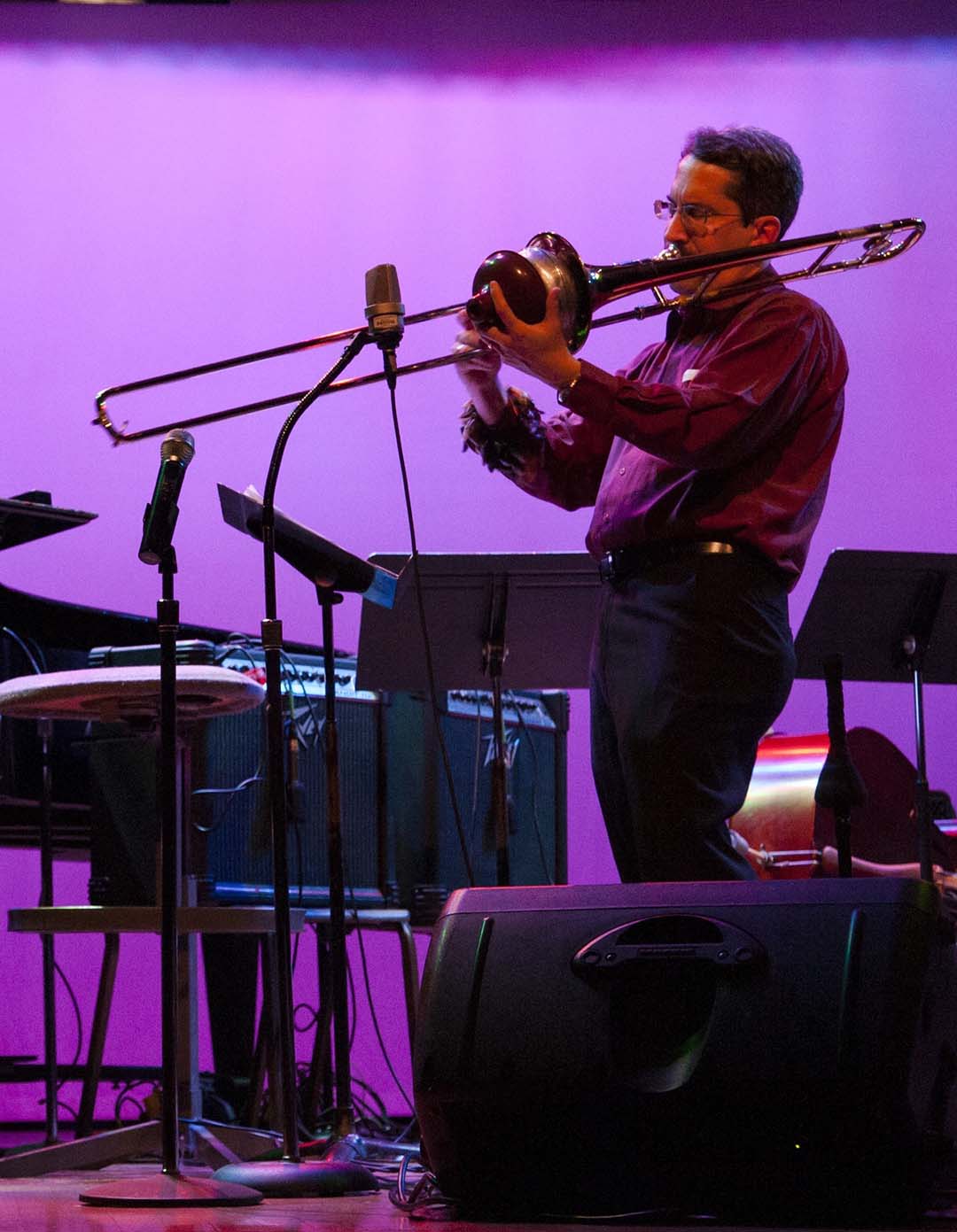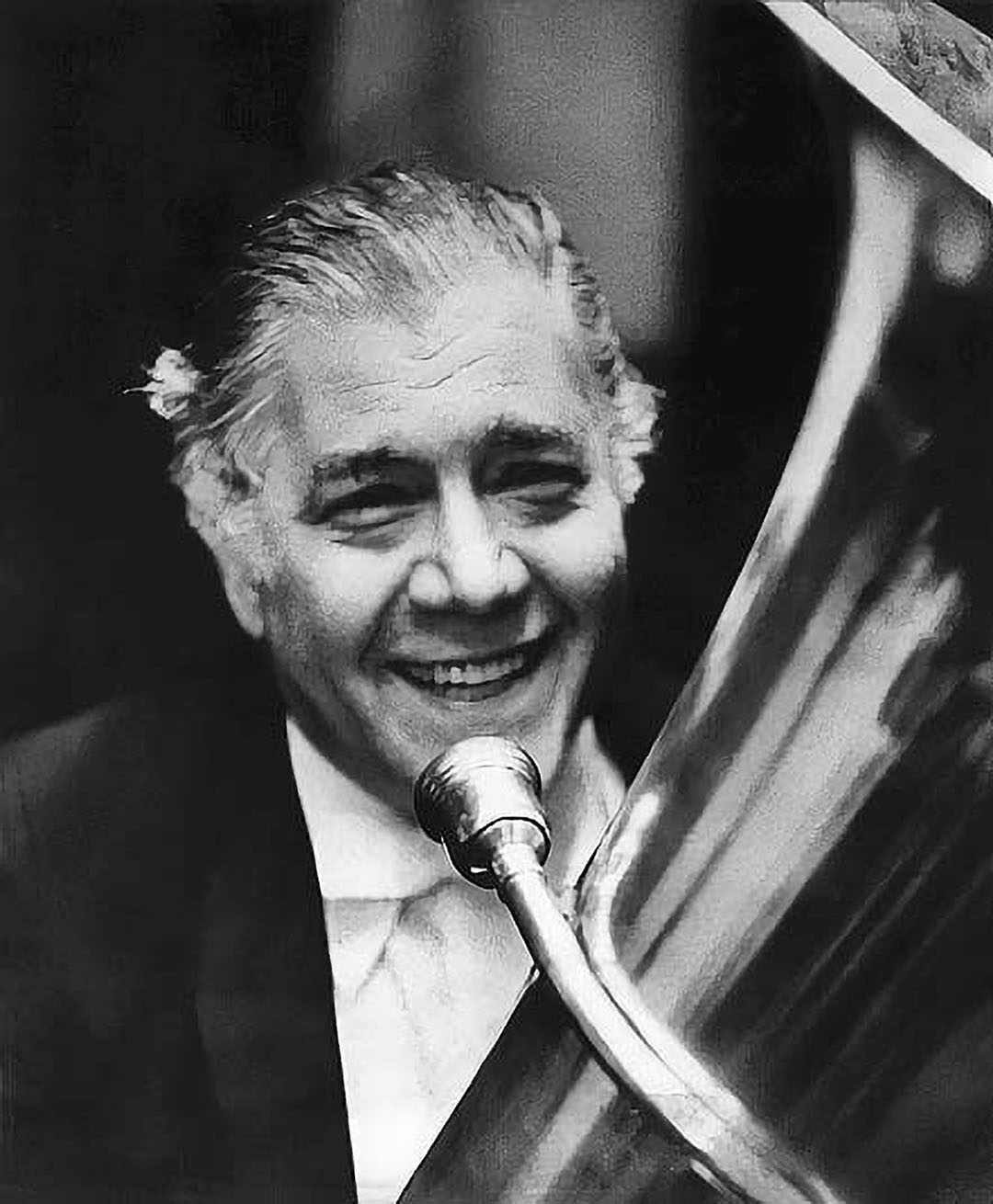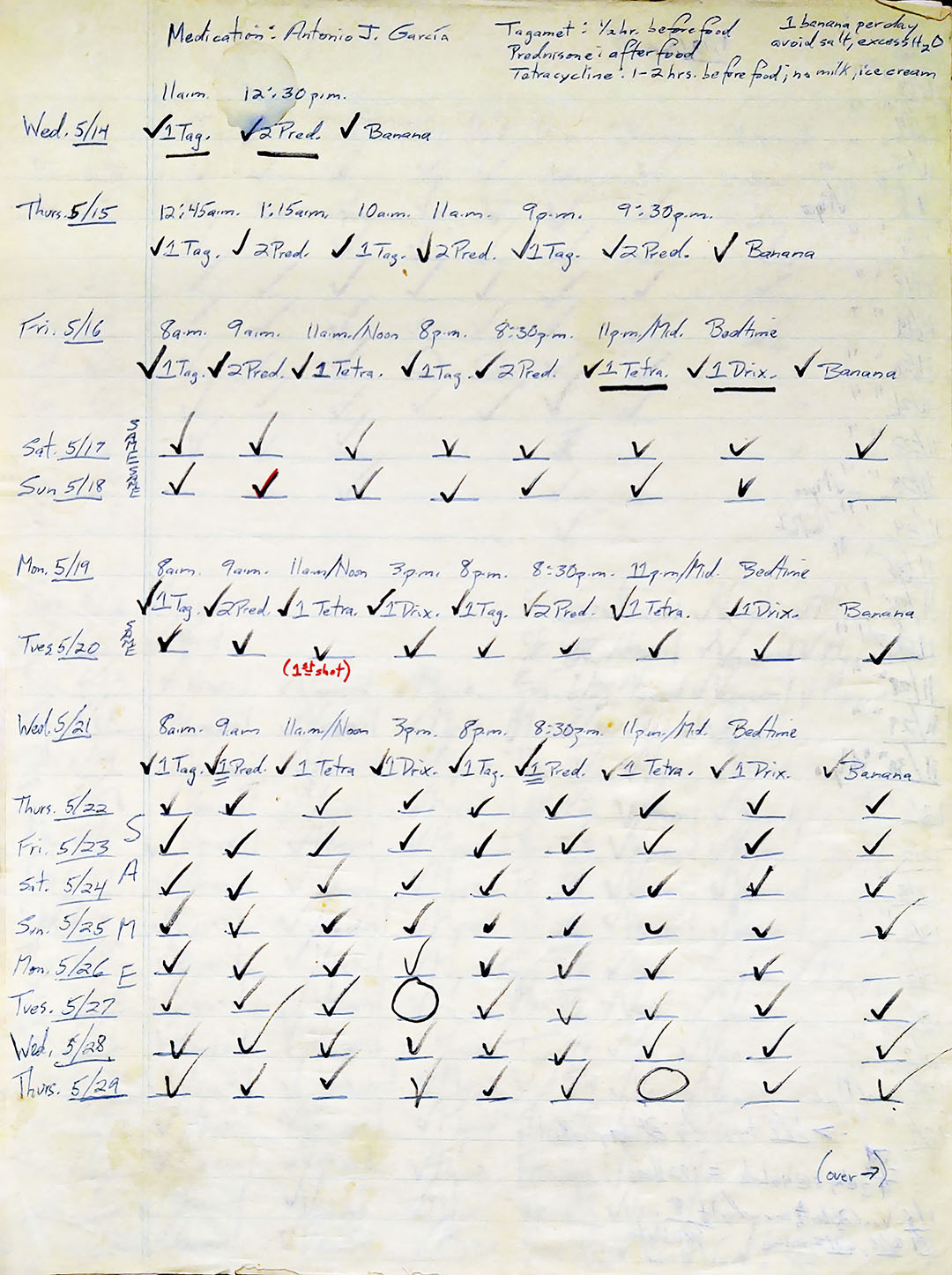
|
Dale Clevenger.
photo credit:
courtesy
The Instrumentalist |
Revelation I
When I was in college Dale Clevenger, then
principal French Hornist with the Chicago Symphony Orchestra, came to my school,
Loyola University of the South in New Orleans, as a guest artist/clinician. At
one point he, my classical trombone teacher Richard Erb, and my Concert Band
director Joseph Hebert lined up a half-dozen student brass-players, including
me, to breathe in and out of plastic bread-bags in a closed system. Everyone
else’s bag cycled in size—big/small, big/small—while mine got bigger/bigger/bigger,
until full. Clevenger looked at me and exclaimed in his deep Southern drawl, “Sunnnnnn:
wha-yat the HECKKKKK are yooouuuuuu DOOOinnnn’?”
He had me do the exercise again; and he confirmed: “Clearly
you’re not breathing in a closed system.” In my invented word, I was “snore-breathing”
when playing the tenor trombone. I was taking in air the way I did nearly a
third of every day while sleeping, plus a good deal of the daytime, all while
regularly partially congested: I was breathing in through my mouth and my nose at the same time—which can only be accomplished if you raise the back
of your tongue up a bit or tense your soft palette to engage airflow to your
nose.
Richard Erb.
photo credit: Michael Grose, courtesy Peter Erb
|
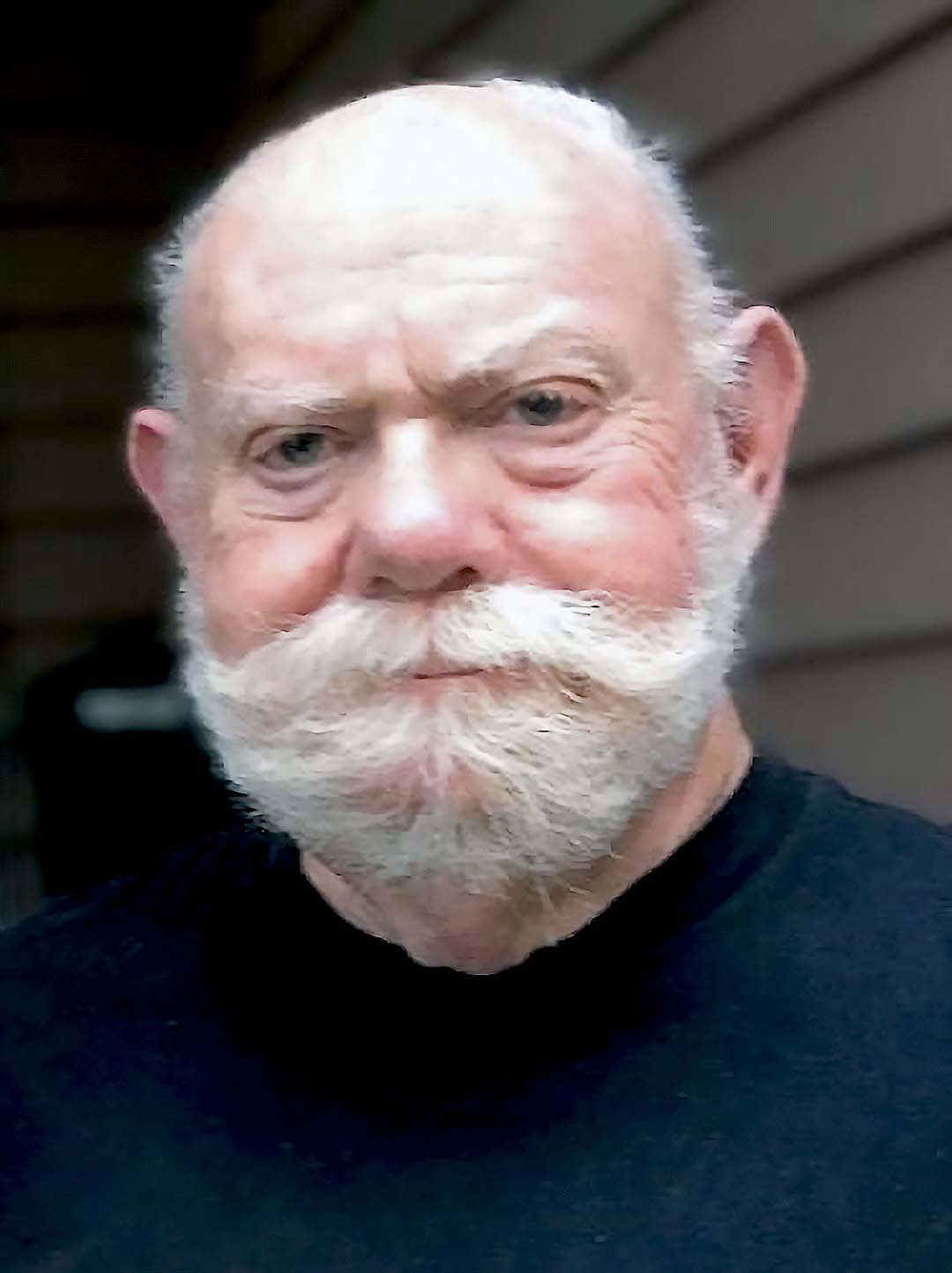
|
That day it took me more than a few minutes of
conscious focus to place my tongue completely down so that I could make the bag
rise and fall like everyone else’s did. It was not easy at first, nor could I
consistently accomplish it. I was shocked, being an almost-20-year-old who
obviously had no idea how to breathe in and out; but that was consistent with
my lifelong history of allergies and asthma: there was no way I would know how others breathe. I was breathing the only “natural” way I knew—which
was unnatural to people who could breathe well.
Clevenger and Erb had both been students of the
legendary CSO tubaist and breathing-guru Arnold Jacobs. Later, in 1980, I went
and took lessons with Jacobs myself, which certainly transformed my musical
life in ways for which Erb had already paved the way.
Erb had told me in one fateful lesson that
year that he didn’t want me to jump out of a window but that I was returning to
each weekly lesson with the same sound-production problems. He felt my studying
even briefly with Jacobs would jumpstart a positive change, and I agreed to
seek lessons with him that Summer. Erb also recommended that prior to my
arrival I mail Jacobs a letter describing my applicable medical history, recent
medical treatment, and possible medically related problems affecting my
music-making. Given Jacobs’ years of formal and informal medical study, he
would immediately understand the context—not that he needed it in order to
improve my playing. The following facts are drawn from that letter.
Medical History
In June of 1980, with a long history of
rhinosinusitis and nasal polyps, I once again underwent examinations from both
an Allergist/Immunologist and an Ear, Nose, and Throat specialist. On the
bright side, my lungs were clear. But a sinus infection was noted, along with a
large number of small, ethmoid polyps. The nasal mucous membranes were
extremely pale, boggy, and approximately 80% blocked. The tympanic membranes (ear
drums) were glistening; and the posterior pharynx (aside the tonsils) was edematous
(swollen with fluid) and injected (congested). Blood tests revealed my IgE (immunoglobulin) level to be 150 (on the higher
end) but my Eosinophil (a white blood cell) count to be 528 (normal
range being 30-350). As has been the case throughout my life, the nurses
tending my series of scratch-tests could not conceal their surprise at viewing my
extreme reactions to all my usual allergens—but it has never been a surprise to
me.
At six months of age I’d
had a severe respiratory tract infection and was on respiratory restrictions
during exercise for three years. I was a highly allergic individual, sensitive
to virtually everything that grew or moved (including being allergic to human
mold!). At the age of 8 I began 18 months of immunotherapy (allergy shots),
resulting in moderate improvement; but over the following decade (overlapping
my starting trombone at age 13) allergic reactions grew; and breathing
worsened. I had moderately severe bronchial asthma until about age 19. A bout
with mononucleosis at age 20 seemed to prompt a relapse into a more severely
allergic state. It was no surprise that cigarette smoke—a staple in the
environment of jazz and nightclubs in which I regularly performed—markedly aggravated
my situation. I often played shows backing such artists as Ella Fitzgerald and
Mel Tormé with a pile of Kleenex concealed in my lap for use during measures of
rest.
|
Page 1 of 4 of the author’s May-November 1980 dosage log.
photo credit: courtesy Antonio García |
Medical Interventions
Surrounding the above
examinations I underwent the following treatments to shrink swelling and lower other
allergic reactions:
· Over the span of May
14-June 8, 1980: 60 Prednisone (steroid) tablets, 40 Drixoral (dexbrompheniramine and pseudoephedrine) tablets, 30
Tetracyclin (antibiotic) capsules, and 46 Tagumet tablets (to mitigate the
stomach-issues caused by the other medications).
· Over the course of June
10-July 20, 1980: 2 Afrinol tablets (discontinued because the pseudoephedrine had
aggravated the worsening problem of a racing pulse), 85 blasts of Vanceril (topical
nasal Beclomethasone steroid) in each nostril, and at least 22 oral treatments
with a Mycostatin suspension (to mitigate the potential of fungus stemming from
the antibiotics’ killing of friendly bacteria in my mouth and digestive
system).
· Ongoing use of Vanceril,
Mycostatin, and an outlined program of immunotherapy shots (approximately a
dozen by the Chicago trip).
My doctors reported
that due to the above treatments my nose had improved from 10% efficiency to
70%. However, this increase had not been accompanied by any noticeable
improvement in my trombone-playing. In addition, the pseudoephedrine prompted many occasions when my pulse
was 120 sitting at rest. Initiating trombone-playing would often spike my pulse
into the 160s or higher. If I were home and opted to set the trombone down and
rest for a few minutes, I’d often wake up an hour or more later, exhausted.
These conditions lasted for months past my last consumption of the medicine; so
I learned and employed numerous mindful techniques to regulate my pulse so that
I could not only play trombone but live productively during that time.
Musical Challenges
When playing trombone I’d encountered the
following situations regularly:
· Inconsistency of
sound production (attack and tone).
· Lack of breath
control, air movement (including the Valsalva Maneuver).
· Tendency to contract stomach and raise diaphragm while inhaling.
· Inability to
circular breathe.
· Insensitivity of the
lips, with periodic edema (swelling).
· Lack of flexibility,
inability to trill.
· Inability to
consistently tongue in a marcato style in any range, particularly at louder
volumes.
· Constriction of and
vocalization in the throat, particularly when tonguing.
· Inability to cleanly
attack (even singularly) any note in the range above F1, despite a legato range
often exceeding F2.
· Occasional
uncontrollable “octave-doubling” while playing.
· Preoccupation with
biological feedback (“how it feels”) over musical feedback (“how it sounds”).
· Inability to “teach
myself,” to eliminate problems that recurred after previously having been
solved.
You may have surmised by now that I was
by no means a “natural” player of the instrument. And by the age of 21,
entering my senior year at Loyola University of the South in New Orleans (where
I majored in Jazz Studies), and after eight years of playing trombone, I could
see that any technical improvements had slowed to a stop. The previous year in
particular had seen few advancements in my playing style, those advancements
owed to a gradually better knowledge of general musicianship. I could find
little satisfaction in the classical music medium (in which I wanted to
participate) and encountered continual obstacles to jazz-playing as well. That
said, I was gigging constantly in my native New Orleans, performing 15-30
engagements a month primarily playing written music in jazz, pop, and classical
genres while doing everything I could imagine to circumvent the issues noted
above.
Knowing that Jacobs
expected me to call him once I’d arrived in Chicago to then arrange my
lesson-times with him, I planned a trip there for four nights and three days. I
was eager to get whatever time with him I could. My accommodations at the
Pick-Congress Hotel were just down the block from his studio at the Fine Arts
Building, Room 428, 410 South Michigan. I shipped my tenor trombone from New
Orleans via Federal Express in considerable packing materials rather than leave
it to the airline of the day. I had just turned 21, and this was my first
plane-flight.
I am an aggressive
note-taker and still have my assignments handy from every undergraduate and
graduate trombone lesson I’ve taken. My mindset was no different during my
lessons with Jacobs; and though I did not write constantly during those
lessons, I exited the studio only as far as to sit down on the bench outside
his Room 428, where I wrote for as much as an hour following. While sitting
there I met others of his other occasional students, including a bassoonist
from the Bavarian State Opera (Munich, Germany). It was clear confirmation that
Jacobs’ advice was sought across any instrumental or geographic boundaries.
Visit 1, Lesson 1: Wednesday, August 6, 1980, 2-3p.m.
Jacobs asked me what instruments I played (trombone,
some piano) and what my academic concentration was (jazz). He then invited me
to play anything for him; so I played the melody to “Polka Dots and Moonbeams” (Ex.A) at a suppressed volume, including some notes that wouldn’t speak.

|
Ex. A: Polka Dots and Moonbeams.
© 1939 Bourne Co., My Dad's Songs Inc., Marke Music Publishing Co. Inc., Pocketful of Dreams Music Publisher, and Reaganesque Music Co. |
He then asked
me to perform some classical; so I played Pichareau #1 (Ex.B),
still with some hesitation in the notes.

|
Ex. B: Pichareau 21 Etudes for Trombone, #1.
© 1960 Alphonse Leduc |
He invited me to play some extremely
familiar material; so I delivered Rochut #2 (Ex.C), with much
silence between notes.

|
Ex. C: Rochut Melodious Etudes for Trombone, #2.
©1928 Carl Fischer Inc. |
With my permission, he then
took my trombone and played it with a far better sound than I had. He explained
the conceptual difference between “pressured” air (wind locked inside the body)
and “thick” air (wind moving outside the body), offering that my air was suppressed
inside my body and that the little air that was moving was being interrupted by
the movement of my tongue and by abdominal isometrics.
Jacobs then brought out
a spirometer: an instrument gauge with a tube-attached funnel, measuring not
wind-flow power but wind-flow steadiness. My airstream barely moved the meter;
yet when he blew into it, his air swung the readings fully across the scale. He
said I should visualize the air separating the pages of the music in front of
me, thus thinking of air moving outside the body, not concerning myself
about proper internal (i.e. lung) movement and the like.
The steadiness of my
airstream then immediately improved vastly.
Jacobs offered that I had
a relatively small lung capacity (perhaps approximately 4 liters); so I must
use all my capacity to keep up with players having 6 or more liters. He
said I must try to forget about “feel” (physical feedback). Instead, concentrate
on pre-hearing my desired sound in my head, not worrying about the
actual results as much, and thinking not at all about proper internal function:
function must be a natural act.
To demonstrate, without
warning he threw a pencil at me, which I caught. Jacobs said that proper
breathing would be the result of the same unconscious response to stimuli. So
concentrate on pre-hearing: that artistic input in his estimation was
85% of the requirement. The other 15%, the physical motor movement, requires
only the simplicity of a 5-year-old catching a ball.
My sound was then much
improved.
The author in vocal and instrumental settings.
photo credit: courtesy Antonio García
|
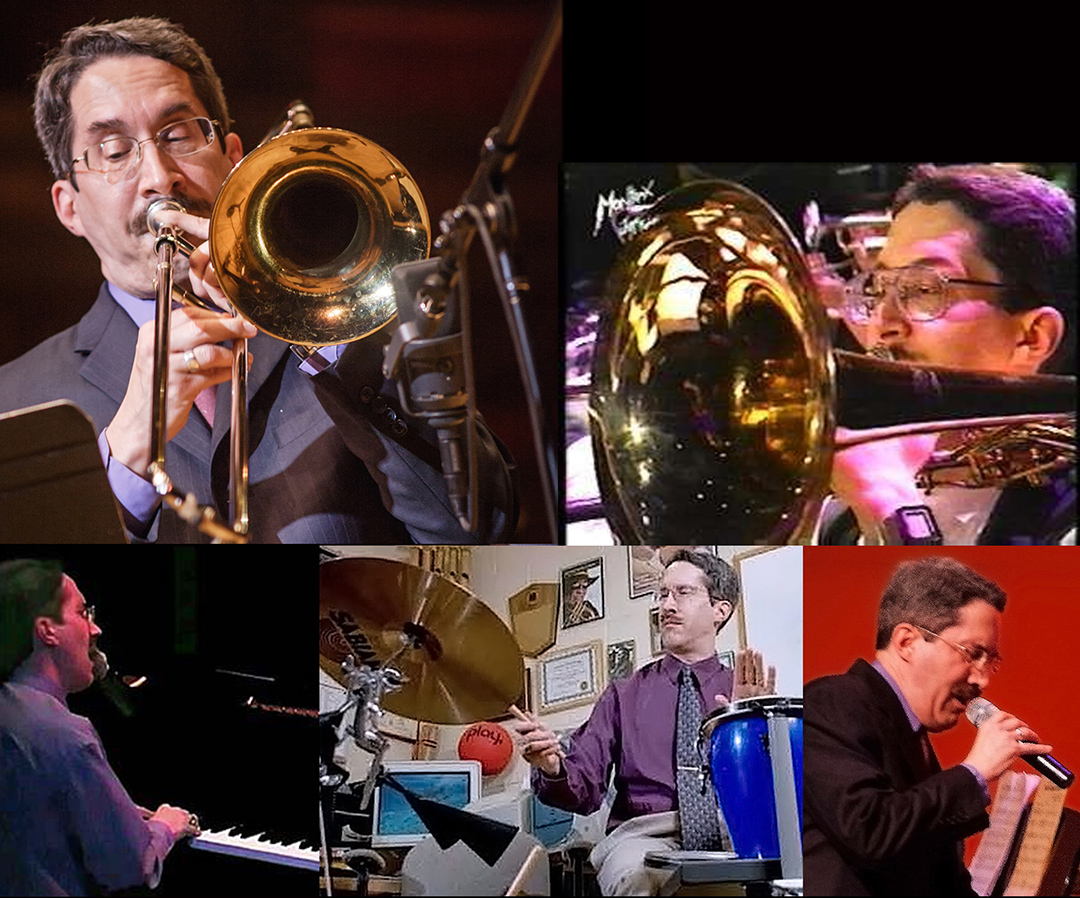
|
Jacobs then brought out
an incentive spirometer: an instrument with two ball-gauges (one for inhaling, one
for exhaling) attached to hoses leading to one mouthpiece. He asked me to buzz
a mid-range note at an intensity necessary to maintain exhalation at a certain
rate. He then removed the mouthpiece and asked me to inhale and exhale (with
steadiness, not power) into the hose so as to move the balls consistently up to
certain level. When I was doing this regularly, he asked me to glance into the
mirror at the result: proper chest-movement created by proper windflow. (Both
Jacobs and Erb encouraged use of the word “wind,” which suggests movement,
rather than “air,” which may suggest a static presence.)
He instructed that I
must visualize the images of the ball-scale and steadiness-meter while playing
so as to improve more quickly. This visualization during performance appeals to
the memory of an additional sense other than hearing: sight, thus
reinforcing my intent to my brain. The brain, subconsciously knowing
much more about my functions (and disabilities) than I do consciously, will direct
my body as it needs to in order to duplicate the sound I’ve pre-heard.
Jacobs invited me to
read Rochut #2 again. He stopped me after a few bars, picked up a book, and
began reading in a monotone, explaining that’s how one reads for information. Then
he began reading as if delivering a speech, explaining that’s how one
communicates to someone else. He said we make the same difference while
performing music: never allowing oneself to read for information, even
during practice. His reason anatomically is that the fifth and seventh
cranial nerves are attached to the embouchure. The fifth receives physical
feedback (i.e., a sensor nerve for “learning”); the seventh is a motor nerve
that, given proper stimuli, operates the lips for “presentation.” We must be
sure that attention is given to presentation at all times.
I must state here that
prior to this lesson I had often wondered as to how it was possible that I
could have occasions when my embouchure had felt terrible while I played
markedly well, as well as occasions when my embouchure had felt great while I
played poorly. Every brass-player I’ve ever discussed this with has experienced
the same. And the reason, simply put, is that the nerve that tells the brain
how our “chops” feel is completely different from the nerve from the brain that
operates those “chops.” So if our mental focus is correctly aimed at
pre-hearing our sound, it is possible to override poor physical
sensations with a directed mental image. And conversely, if our mental focus is
poor, a great embouchure and windflow may not result in a fine performance.
I then played Rochut #2
with improvement.
He suggested that I work
on smaller phrases with proper sound now, saving more lengthy phrases for
later. He emphasized that I must not be subjective while playing: I cannot
analyze and play simultaneously. I must be objective: perform!
He then asked me to play
some jazz, requesting the “When The Saints Go Marching In” melody. My rendition
ignored the word “the” and loudly hit “Saints.” When requested to sing it, I
surprisingly sung it the same way. So he asked me to play the melody again,
emphasizing the note for “the.” I was unsuccessful. But when he then asked me
to pre-hear what that new version should sound like, I delivered the
phrase successfully.
He asked me to play the
Arban scales on (my edition) p.63, #1 (Ex.D).

|
Ex. D: Arban’s Famous Method for Slide and Valve Trombone, p.63, #1.
©1936 Carl Fischer Inc. |
My playing
emphasized some notes over others. But when he then asked me to pre-hear a
smooth version, it worked: I delivered evenly phrased scales.
He then stated
something I’d heard from Richard Erb many times before. When exploring new
phrasing, the physical feedback I received would different than before. But “different”
didn’t mean “wrong” any more than “familiar” meant “right.” (As I have often since
stated to my own students, my two criteria for assessing a new result are: “does
this version suit the genre better?” and “is anyone hurt?” If it sounds better
and there’s no apparent injury to one’s embouchure or nearby musicians’ ears,
you’re probably onto a good thing!)
Jacobs said that I must
expect, though, that some skills would be weaker when playing in this “new” style until I’d worked on them sufficiently. He suggested
that I buzz jazz melodies on the mouthpiece—nothing slow enough to self-analyze,
just performing on the mouthpiece—for at least a half hour per day.
(Doing so on my bass trombone mouthpiece in later years also had a profoundly
positive effect unlocking a melodious style on that instrument.)
He closed the lesson
saying that we must meet again to work on the movement of my breathing (so as to
lose abdominal tenseness) and use of my lung capacity.
Visit 1, Lesson 2: Friday, August 8, 1980, 11a.m.-Noon
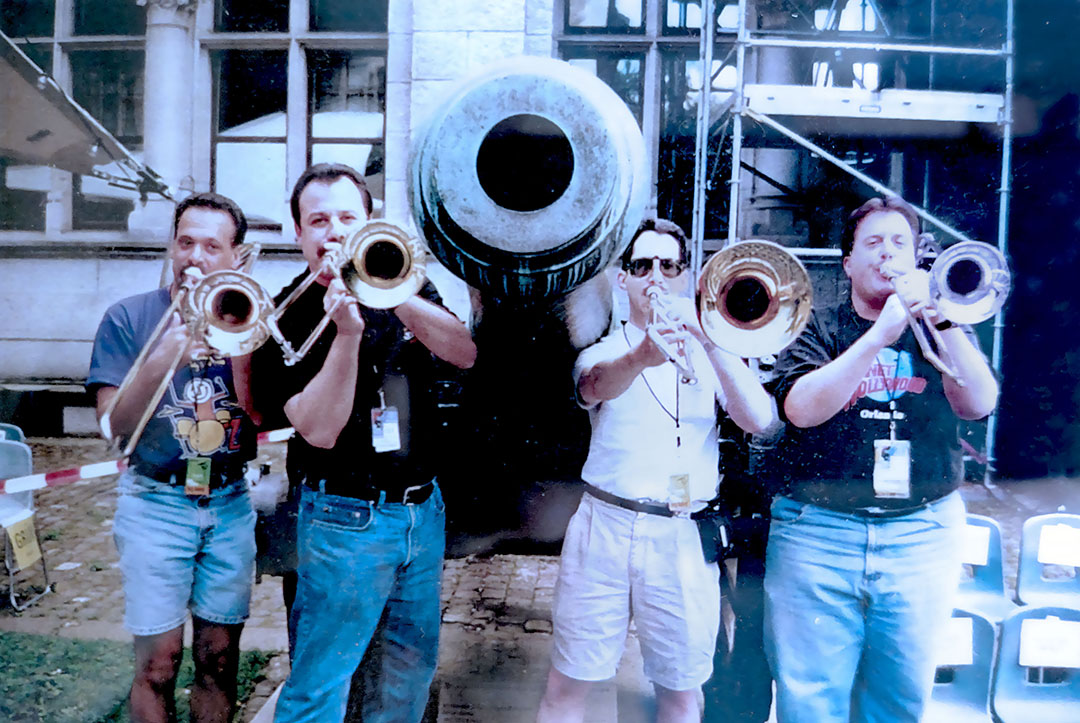
|
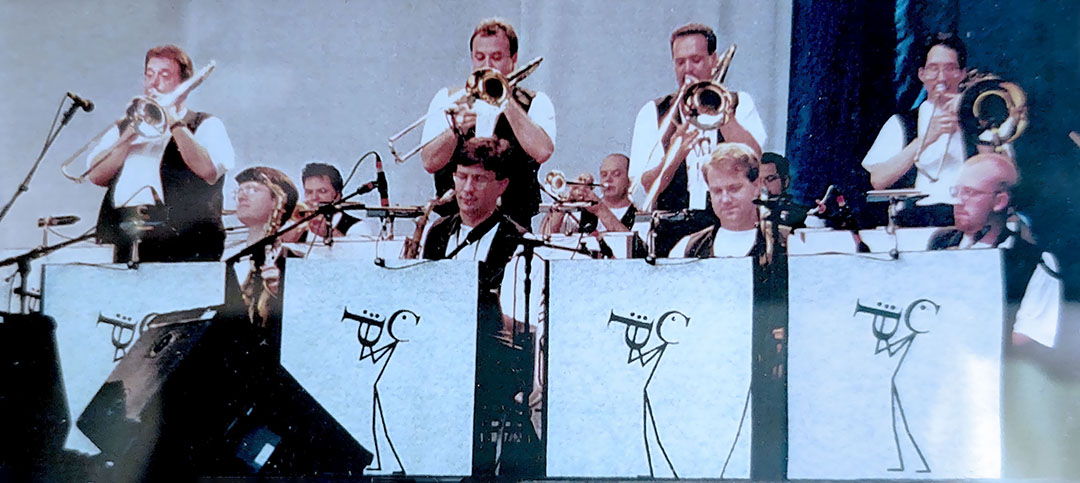 |
"Four Cannons and a Relic": The Phil Collins Big Band trombone section pre-concert at the Zürich Landesmuseum, 1998. Mark Bettcher, Arturo Velasco, Antonio García (bass trombone), and Scott Bliege.
photo credit:
courtesy Antonio García |
The Phil Collins Big Band trombone section: Scott Bliege, Arturo Velasco,
Mark Bettcher, and Antonio García (bass trombone), 1998.
photo credit:
courtesy Antonio García |
After I briefly warmed up, Jacobs emphasized that
I must give each note equal importance, must picture the sound in my head. He again
brought out the incentive spirometer (with two ball-gauges, one for inhaling,
one for exhaling) and asked me to make the two levels match while breathing. He
stated again that my pulmonary function was fine but that I must use it fully. After
I played some scales, he again emphasized equal importance to all notes.
Jacobs explained that I
should visualize breathing in and out of my mouth, not out of my lungs
or body, because otherwise my muscles would move in a fake manner mimicking air
intake while actually not filling my lungs to capacity. He asked me to move my
stomach to enlarged and shrunken positions without breathing so as to
notice this “black and white movement” of the expanded and emaciated stomach walls.
He then suggested that I think of breathing not
as horizontal expansion and contraction but instead as vertical, like a piston.
About half the air supply involves lowering the diaphragm; if that instead raises
during intake, considerable air is lost. And yet, he said, I could not specifically
order my diaphragm to move, any more than I could order my spleen to do so: my
diaphragm would move when air moved properly in and out of my mouth, thus
expanding and contracting the lungs above the diaphragm.
My decibel level was generally
too quiet; my expectation of what was coming out of the bell didn’t match the
decibel meter’s assessment. He told me that I should practice with a strong,
soloistic forte so that there’s room to crescendo and decrescendo, and with
equal importance to each note.
Jacobs stated that our
lungs have the capacity to hold so many ounces of air, but our abdominal muscles
have capacity to exert 10 or 12 pounds of isometric force when used in
opposition to each other. So we must weaken all our muscles in the abdominal
area when playing so that there’s room to be flexible with our air and sound.
He stated that “strength is your enemy; flabbiness is your friend.”
He suggested I over-breathe
(breathe “too often”). Have air to waste: don’t get caught playing while in the
downward end of the respiratory curve. If need be, shorten phrases in favor of maintaining
a soloistic sound; length will come later.
Jacobs informed me that
the reason why my stomach wall wouldn’t expand during inhalation was because I
had never contracted it during exhalation! So he emphasized that I must, for a
while, give conscious attention to my abdominal movement in order to create new
stimuli. Eventually new, natural stimuli would take over the function without
my conscious attention.
He asked me to play long
tones: Arban p.17, #1 (Ex.E).

|
Ex. E: Arban’s Famous Method for Slide and Valve Trombone, p.17, #1.
©1936 Carl Fischer Inc. |
Practice giving full attention to picturing
the sound and (for a while) to proper abdominal movement. Play jazz ballads at
strong volumes.
His summary to me was
that simplicity, in general, is the key for solving most physical problems.
Given the proper musical picture, the brain will command the proper motor-work
(i.e., catching the pencil). Brass-players, unlike woodwind-players, have “flesh
and blood reeds.” By playing at consistently louder volumes, the lips will
learn to respond; otherwise, they can lock off air just as abdominal tension
and tongue-placement had for me before this day.
Most importantly, give
attention to the “art” over the motor-mechanics.
Interlude
The improvements to my playing were immediate,
profound, and in majority lasting. Also important was the feeling of relief that overcame me after even the first lesson: relief that endless performance-problems
seemingly out of my control were now becoming matters I could control. I
had a future. By no means had I become a virtuoso player, but I had received
stimuli and direction from Jacobs that supercharged the perspectives already
given me by Erb and more. In the months following, I was actually improving in
lessons and on my own and enjoyed a senior year less fraught with negativity
surrounding the trombone. I was focusing on pre-hearing my sound and far less
so on the mechanics of trombone-playing.
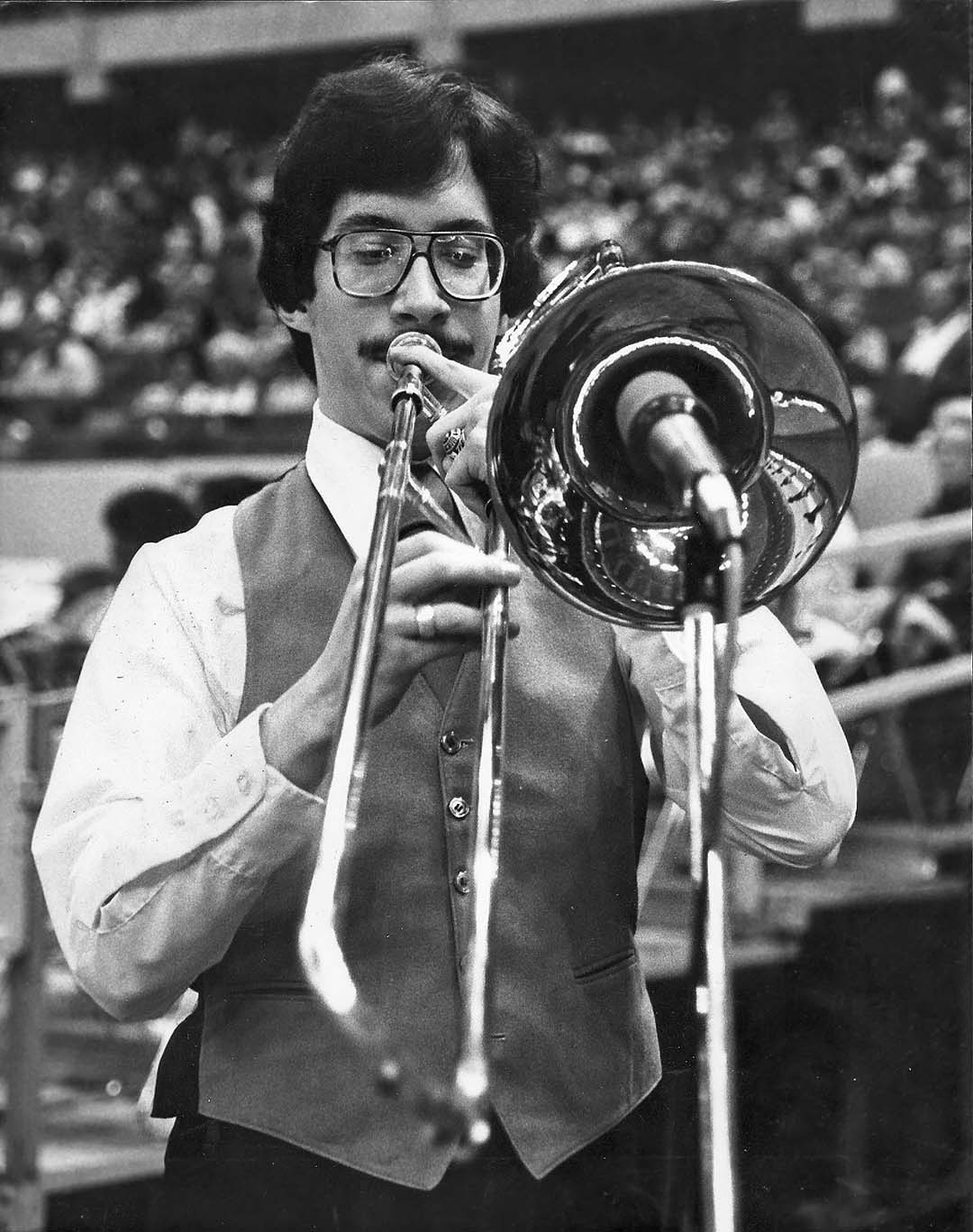
|
García as tenor trombonist of the New Orleans Saints Combo, circa 1980, a recurring job he received from Dr. Joseph Hebert, providing experience in front of 70,000 attendees each game.
photo credit:
José L. García II |
Prior to my lessons
with Jacobs, I had actually been doing isometric abdominal exercises as a
workout. But given his assessment that I had been exerting those muscles unnecessarily
while playing, to my airstream’s detriment, I gave up those exercises
immediately. Perhaps I could have learned to relax my abdomen during
performance while continuing my workout-regimen, but I decided I needed every
bit of momentum on my airstream’s side while proceeding to learn how to focus
on pre-hearing my best sound of the music before me. I was also aware that
others’ pedagogical approaches actually favored using isometric tension as a
breathing tool, but I was not interested in exploring an aspect of abdominal
tension so closely related to my previous difficulties.
I’d listed the Valsalva
Maneuver as one of my musical challenges. You can find plenty of information
online regarding this tense way of breathing, including statements from Richard
Erb within his article/book-chapter listed below. As a form of bearing down
while breathing, it requires a closed glottis so is utterly contradictory to
good windflow. My first lesson with Jacobs freed me from my subconscious use of
the Valsalva Maneuver, yet he had never mentioned the topic. It was simply
impossible for me to employ that tense tactic while pre-hearing the desired
music and visualizing my airstream moving vertically through my torso and out
my mouth at the pages of music I sought to move. Such a change emphasized to me
the pedagogical concept shown me by both Erb and Jacobs: saying “no” to a bad
habit is rarely effective; but it is often easy to introduce a new, more
desirable habit to overwrite the old one. Erb would at times overwrite my
body’s tension by placing me in his office chair and requesting that I play
Rochut #2 or similar while he gently wheeled me back and forth and around the
space. I had to let go of the rigidity of my body in order not to fall out of
the chair, resulting in better tone and attacks that I could then recapture
while standing.
I should mention that
Jacobs’ pedagogical manner was unimposing. He immediately conveyed a welcoming
attitude, as if I were an invited guest to his home. He offered his
instructions as the suggestions of a mentor I’d requested join me, not
posturing himself as an acclaimed god whose every word should be inscribed on a
granite wall. I thought of him in a grandfatherly way—a grandfather with
tremendous knowledge—and if Richard Erb were a mentoring trombone-father to me,
then that analogy regarding Jacobs was appropriate.
I definitely felt our relationship was
founded on two-way respect: I of course entered the room seeking his pending
perspectives during my lesson; but my feeling was that he also respected that
I’d invited his insights. Not every student senses that coming from a teacher
during lesson one, but I was fortunate to receive that from each of my formal
trombone and jazz mentors.
After graduating with
my B.M. in Jazz Studies in May 1981, I decided in the Fall of that year to
audition for graduate school the following Spring for potential entry Fall
1982. My chosen destination was The Eastman School of Music, whose jazz and
classical recordings I had heard and where many of my professors had attended.
John Mahoney (left) with Garcia at a Ray Wright Tribute concert, Eastman School of Music, October 2012.
photo credit: courtesy Dorien Mahoney
|
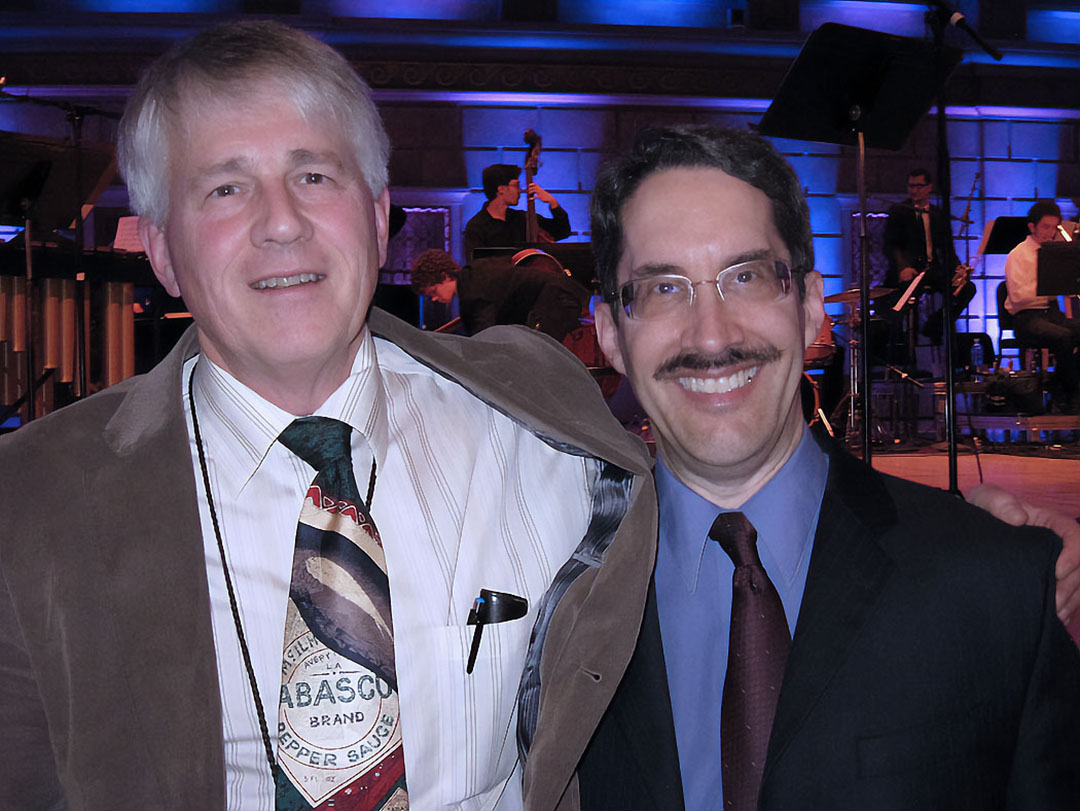
|
My jazz trombone and arranging teacher, Prof. John Mahoney
(an Eastman alumnus), advised me that he could not yet recommend me for
graduate jazz performance but suggested I showed promise towards entry into a
graduate jazz writing degree. Towards that end, I began assembling my writing
portfolio and practicing my trombone towards that goal while continuing to gig
heavily in New Orleans. His advice would soon change my life for the better.
Meantime, one airline was
offering an option for multi-city routing at a very low price; so I scheduled
an itinerary for February 1982 that began with in Rochester, NY for my Eastman
audition, then took me to Giardinelli’s in New York (where I purchased my bass
trombone) and Chicago (to study again with Jacobs) before returning to New
Orleans. I was fortunate to receive one more lesson from Arnold Jacobs.
I was not fortunate in that the trunk
in which I’d transported my horn was lost on the shuttle van ride from the
Chicago airport to my hotel. After calling all the preceding hotels on the
shuttle route, I had to file a police report and then contact Jacobs for a referral
to a local music store. It was so kind to rent me a wonderful trombone for a
few days at such a low cost that could only have been due to the value of a
referral from Arnold Jacobs. I also had to venture out in the snowy city to buy
a couple of sets of winter clothes for my stay, as mine were in the trunk!
(Part 2 of this article, to be published July 2025, will explore the author’s third lesson with Jacobs and lessons learned since, plus additional medical interventions, confirmations of Jacobs’ pedagogy, subsequent revelations, and potential exercises, with nine more videos.)
* * *
Richard Erb.
photo credit: Michael Grose, courtesy Peter Erb
|

|
This article is dedicated to Richard Erb,
with whom I studied from September 1977-June 1983. He passed away April 25,
2023, leaving behind a legacy of so many accomplished low-brass musicians whom
he had mentored over his career at Loyola University New Orleans and for the
National Youth Orchestra of Canada, as well as decades of marvelous
performances as bass trombonist of the New Orleans Symphony and Louisiana
Philharmonic Orchestra. Read his article “The Arnold Jacobs Legacy,” published
in The Instrumentalist of April 1987 and republished that same year as a
chapter within the book Arnold Jacobs: Legacy of a Master by The
Instrumentalist Company. Text of that chapter can be found
online. View a lengthy video-interview with Erb
regarding Jacobs’ mentorship on TubaPeopleTV with Michael Grose. And in the December 1983 The
Instrumentalist you can read “The Dynamics of Breathing with Arnold Jacobs
and David Cugell, M.D.” by Kevin Kelly.
_ _ _ _ _ _ _ _ _ _ _ _ _ _ _
Antonio J. García is a Professor Emeritus and former Director of
Jazz Studies at Virginia Commonwealth University, where he directed the Jazz
Orchestra I; instructed Applied Jazz Trombone, Small Jazz Ensemble, Jazz Pedagogy, Music
Industry, and various jazz courses; founded a B.A. Music Business Emphasis (for
which he initially served as Coordinator); and directed the Greater Richmond
High School Jazz Band. An alumnus of the Eastman School of Music and of Loyola
University of the South, he has received commissions for jazz, symphonic,
chamber, film, and solo works—instrumental and vocal—including
grants from Meet The Composer, The Commission Project, The Thelonious Monk
Institute, and regional arts councils. His music has aired internationally and
has been performed by such artists as Sheila Jordan, Arturo Sandoval, Jim Pugh,
Denis DiBlasio, James Moody, and Nick Brignola. Composition/arrangement honors
include IAJE (jazz band), ASCAP (orchestral), and Billboard Magazine (pop
songwriting). His works have been published by Kjos Music, Hal Leonard, Kendor
Music, Doug Beach Music, ejazzlines, Walrus, UNC Jazz Press, Three-Two Music
Publications, Potenza Music, and his own garciamusic.com, with five recorded on CDs by Rob
Parton’s JazzTech Big Band (Sea Breeze and ROPA JAZZ). His scores for
independent films have screened across the U.S. and in Italy, Macedonia, Uganda, Australia, Colombia, India, Germany, Brazil, Hong Kong, Mexico, Israel, Taiwan, and the United Kingdom. One of his recent commissions was performed at Carnegie Hall by the Orpheus Chamber Orchestra.
A Conn-Selmer trombone clinician, Mr. García serves as the
jazz clinician for The Conn-Selmer Institute. He has freelanced as trombonist,
bass trombonist, or pianist with over 70 nationally renowned artists, including
Ella Fitzgerald, George Shearing, Mel Tormé, Doc Severinsen, Louie Bellson, Dave
Brubeck, and Phil Collins—and has performed at the Montreux, Nice, North
Sea, Pori (Finland), New Orleans, and Chicago Jazz Festivals. He has produced
recordings or broadcasts of such artists as Wynton Marsalis, Jim Pugh, Dave
Taylor, Susannah McCorkle, Sir Roland Hanna, and the JazzTech Big Band and is
the bass trombonist on Phil Collins’ CD “A Hot Night
in Paris” (Atlantic) and DVD “Phil Collins:
Finally...The First Farewell Tour” (Warner Music). An avid scat-singer,
he has performed vocally with jazz bands, jazz choirs, and computer-generated
sounds. He is also a member of the National Academy of Recording Arts &
Sciences (NARAS). A New Orleans native, he also performed there with such local
artists as Pete Fountain, Ronnie Kole, Irma Thomas, and Al Hirt.
Most of all, Tony is dedicated to assisting musicians towards finding their joy. His 35-year full-time teaching career and countless residencies in schools have touched tens of thousands of students in Canada, Europe, South Africa, Australia, The Middle East, and across the U.S. His collaborations highlighting jazz and social justice have raised hundreds of thousands of dollars, providing education to students and financial support to African American, Latinx, LGBTQ+, and Veterans communities, children’s medical aid, and women in jazz. He serves as a Research Faculty Member at the University of KwaZulu-Natal. His partnerships with South Africa focusing on racism and healing resulted in his performing at the Nelson Mandela National Memorial Service in D.C. in 2013. He also fundraised $5.5 million in external gift pledges for the VCU Jazz Program.
Mr. García is the Past Associate Jazz Editor of the International Trombone Association Journal.
He has served as a Network Expert (for Improvisation Materials), President’s Advisory Council member, and
Editorial Advisory Board member for the Jazz
Education Network . His newest book, Jazz Improvisation: Practical Approaches to Grading (Meredith Music), explores avenues for creating structures that correspond to course objectives. His
book Cutting the Changes: Jazz
Improvisation via Key Centers (Kjos Music) offers musicians of all ages the
opportunity to improvise over standard tunes using just their major scales. He
is Co-Editor and Contributing Author of Teaching
Jazz: A Course of Study (published by NAfME), authored a chapter within Rehearsing The Jazz Band and The Jazzer’s Cookbook (published by
Meredith Music), and contributed to Peter Erskine and Dave Black’s The Musician's Lifeline (Alfred). Within the International Association for Jazz Education he
served as Editor of the Jazz Education
Journal, President of IAJE-IL, International Co-Chair for Curriculum and
for Vocal/Instrumental Integration, and Chicago Host Coordinator for the 1997
Conference. He served on the Illinois Coalition for Music Education
coordinating committee, worked with the Illinois and Chicago Public Schools to
develop standards for multi-cultural music education, and received a curricular
grant from the Council for Basic Education. He has also served as Director of
IMEA’s All-State Jazz Choir and Combo and of similar ensembles outside of
Illinois. He is the only individual to have directed all three genres of Illinois All-State jazz ensembles—combo, vocal jazz choir, and big band—and is the recipient of the Illinois Music Educators Association’s 2001 Distinguished Service Award.
Regarding Jazz Improvisation: Practical Approaches to Grading, Darius Brubeck says, "How one grades turns out to be a contentious philosophical problem with a surprisingly wide spectrum of responses. García has produced a lucidly written, probing, analytical, and ultimately practical resource for professional jazz educators, replete with valuable ideas, advice, and copious references." Jamey Aebersold offers, "This book should be mandatory reading for all graduating music ed students." Janis Stockhouse states, "Groundbreaking. The comprehensive amount of material García has gathered from leaders in jazz education is impressive in itself. Plus, the veteran educator then presents his own synthesis of the material into a method of teaching and evaluating jazz improvisation that is fresh, practical, and inspiring!" And Dr. Ron McCurdy suggests, "This method will aid in the quality of teaching and learning of jazz improvisation worldwide."
About Cutting the Changes, saxophonist David Liebman states, “This book is
perfect for the beginning to intermediate improviser who may be daunted by the
multitude of chord changes found in most standard material. Here is a path
through the technical chord-change jungle.” Says vocalist Sunny Wilkinson,
“The concept is simple, the explanation detailed, the rewards immediate. It’s
very singer-friendly.” Adds jazz-education legend Jamey Aebersold, “Tony’s
wealth of jazz knowledge allows you to understand and apply his concepts
without having to know a lot of theory and harmony. Cutting the Changes allows music educators to
present jazz improvisation to many students who would normally be scared of
trying.”
Of his jazz curricular work, Standard of Excellence states: “Antonio García has developed a
series of Scope and Sequence of Instruction charts to provide a structure that
will ensure academic integrity in jazz education.” Wynton Marsalis emphasizes:
“Eight key categories meet the challenge of teaching what is historically an
oral and aural tradition. All are important ingredients in the recipe.” The Chicago Tribune has highlighted García’s
“splendid solos...virtuosity and musicianship...ingenious scoring...shrewd
arrangements...exotic orchestral colors, witty riffs, and gloriously
uninhibited splashes of dissonance...translucent textures and elegant voicing”
and cited him as “a nationally noted jazz artist/educator...one of the most
prominent young music educators in the country.” Down Beat has recognized his “knowing solo work on trombone” and
“first-class writing of special interest.” The
Jazz Report has written about the “talented trombonist,” and Cadence noted his “hauntingly lovely”
composing as well as CD production “recommended without any qualifications
whatsoever.” Phil Collins has said simply, “He can be in my band whenever he
wants.” García is also the subject of an extensive interview within Bonanza: Insights and Wisdom from
Professional Jazz Trombonists (Advance Music), profiled along with such
artists as Bill Watrous, Mike Davis, Bill Reichenbach, Wayne Andre, John
Fedchock, Conrad Herwig, Steve Turre, Jim Pugh, and Ed Neumeister.
Tony is the Secretary of the Board of The Midwest Clinic and a past Advisory Board member of the Brubeck Institute. The partnership he created between
VCU Jazz and the Centre for Jazz and Popular Music at the University of
KwaZulu-Natal merited the 2013 VCU Community Engagement Award for Research. He
has served as adjudicator for the International Trombone Association’s Frank
Rosolino, Carl Fontana, and Rath Jazz Trombone Scholarship competitions and the
Kai Winding Jazz Trombone Ensemble competition and has been asked to serve on
Arts Midwest’s “Midwest Jazz Masters” panel and the Virginia Commission for the
Arts “Artist Fellowship in Music Composition” panel. He was published within the inaugural edition of Jazz Education in Research and Practice and has been repeatedly
published in Down Beat; JAZZed; Jazz
Improv; Music, Inc.; The
International Musician; The
Instrumentalist; and the journals of NAfME, IAJE, ITA, American
Orff-Schulwerk Association, Percussive Arts Society, Arts Midwest, Illinois
Music Educators Association, and Illinois Association of School Boards.
Previous to VCU, he served as Associate Professor and Coordinator of Combos at
Northwestern University, where he taught jazz and integrated arts, was Jazz
Coordinator for the National High School Music Institute, and for four years
directed the Vocal Jazz Ensemble. Formerly the Coordinator of Jazz Studies at
Northern Illinois University, he was selected by students and faculty there as
the recipient of a 1992 “Excellence in Undergraduate Teaching” award and
nominated as its candidate for 1992 CASE “U.S. Professor of the Year” (one of
434 nationwide). He is recipient of the VCU School of the Arts’ 2015 Faculty Award of Excellence for his teaching, research, and service, in 2021 was inducted into the Conn-Selmer Institute Hall of Fame, and is a 2023 recipient of The Midwest Clinic's Medal of Honor. Visit his web site
at <www.garciamusic.com>.
